The Greater Dayton Regional Transit Authority proposes redesigning its system in response to changes to local travel patterns stemming from the COVID pandemic and recent job growth and economic investments.
The transit agency proposes adding new service, such as another Flyer-like free shuttle that goes back and forth between downtown and West Dayton, plus three “community connectors” that mainly provide more direct service between areas outside of downtown.
Credit: JIM NOELKER
Credit: JIM NOELKER
About 25 of the Greater Dayton RTA’s more than 2,500 bus stops will be eliminated under the proposal.
The redesign seeks to increase travel options while reducing travel times and the number of transfers riders need to get to their destinations, said Brandon Policicchio, Greater Dayton RTA’s chief customer and business development officer.
“Under a fully implemented redesign, this means an increase to the quality of service (customers) are receiving through more frequent, direct and easy-to-use services,” he said.
Greater Dayton RTA started working on a system redesign in 2018 and released a final plan two years later.
But much has changed since 2020, due to COVID and how the pandemic upended the economy. New development projects also have changed travel needs.
Credit: JIM NOELKER
Credit: JIM NOELKER
RTA proposes four new bus routes (25, 26, 27 and 28), three new community connectors and a new circulator (or free shuttle), plus a new on-demand service zone.
The Central Circulator would be a shuttle service that links up with the Flyer, a popular free bus that travels on a short loop between downtown and Brown Street by the University of Dayton campus.
The new circulator would run east to west, primarily along on Third Street, giving riders a quick way to get between places downtown and in West Dayton, such as the Wright Dunbar historic district and Sinclair Community College.
Connectors
Currently, 16 of RTA’s 18 routes make stops at Wright Stop Plaza Transit Center in the heart of downtown Dayton. The only routes that do not are the Flyer and the North Connector.
RTA launched the North Connector last month, which officials say directly bridges northeast Dayton and Trotwood and multiple areas in between. The connector runs east and west and does not come downtown.
Credit: JIM NOELKER
Credit: JIM NOELKER
The North Connector is an extended route that crosses 10 fixed routes that provides transfer opportunities so riders do not have to come downtown, said Bob Ruzinsky, Greater Dayton RTA’s CEO, during a board of trustees meeting in December.
The transit authority proposes creating a new East Connector and West Connector that travel north and south on opposite ends of Montgomery County. These routes also would not come downtown.
The West Connector would travel between the Northwest Transit Center (on Shiloh Springs Road just east of Salem Avenue) and the Dayton Children’s south campus just south of Austin Boulevard. It would have stops in between at the Westown Transit Center just off West Third Street and the South Transit Center near the Dayton Mall.
The East Connector would link the Meijer store at Executive Boulevard in Huber Heights to the Meijer on Stroop Road in Kettering, with a notable stop at the Eastown Transit Center off Linden Avenue.
Also, a new Airport Connector would travel between downtown and the Dayton International Airport.
The airport area, in addition to offering commercial air service, has become a major employment center. Airport-owned land has been sold and redeveloped into large distribution, warehouse and other types of commercial facilities.
“We believe these connectors will ultimately create better connections and more direct access to jobs, health care and education opportunities, providing an increase in transportation equity,” Policicchio said.
The East Connector will link to 10 routes, while the airport and west connectors will each connect to a dozen.
Parts of the east and airport connectors would serve sections of routes that RTA proposes to discontinue.
Some service discontinued
Greater Dayton RTA proposes discontinuing routes 11, 14, 17, 18, 19 and 43, but the agency says most of the places they serve will not lose transit service.
Under the proposed redesign, bus service will be eliminated for a nearly 1-mile stretch of Schantz Avenue between Far Hills Avenue and Patterson Boulevard (route 11); a half-mile section of Shroyer Road between Far Hills and Stroop Road (route 17); and another half mile part of King Richard Parkway, between Elm Street and Alex Road (route 18).
Between all types of transport, RTA’s system changes will help the agency offer service within a one-quarter-mile distance of 70% of Montgomery County’s population, Policicchio said.
RTA said vehicles would arrive at bus stops on normal routes every 15 to 45 minutes. Connector buses would arrive every 15 to 30 minutes. And the two circulators would arrive every 10 to 15 minutes.
About the Author





